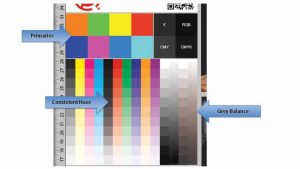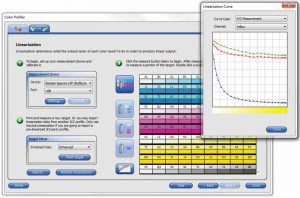For businesses that perform multiple jobs using the same media, the author recommends building profiles that suit their workflow and equipment; it is not as difficult as many fear.
Hitting the spot
Apart from colour settings, output consistency and reliability, reproducing accurate spot colours is a laborious task for many large-format printers and sign shops. The above recommendations will go a long way in simplifying the process, but to ensure accurate spot colours one can draw on three basic tools. First, one must visually check the colour. Secondly, one should use spot colour matching software, and finally, one must opt for colour measurement devices.
Using the correct methods can make eyeballing a powerful tool. The first step is to evaluate the output’s quality by printing a test sheet and looking at the colour scales. Check the greys: these should be equal proportions of CMY. Next, check the hues; they should be consistent in their transitions, along the colour and across different colours. Finally, look at the primary colours to ensure they are in place.
Pantone colour charts and printed samples can also help achieve accurate spot colours, but the chart must be printed on the same media as the final job, otherwise there will be variations.
Colour matching tools are fast and easy to use. To achieve a Pantone colour, users can refer to the colour mapping chart, which looks like the grid of the game Battleship, and compare it to a swatch printed on their output device on the final media. Then, the X and Y values of the best match can be entered into the system to obtain the desired colour.

To achieve a Pantone colour, users can refer to the colour mapping chart, which looks like the grid of the game Battleship, and compare it to a swatch printed on their output device on the final media.
Today, inexpensive colour measurement devices are available that can work with a mobile phone app. These can provide the numerical values of colour in terms of lightness, red/green, yellow/blue (L*a*b) as defined by the International Commission on Illumination (CIE) and the metric for the difference between two colours, Delta-E values. For many companies, investing in higher-end devices will deliver a rapid return on investment (ROI) and significantly reduce ink and media waste.
These methods should become an integral part of the workflow for large-format printers and sign shops and lay the foundation of training new operators. While seemingly basic, they can define the difference between saleable and unsaleable print, and profit and loss.
Gudrun Bonte is the vice-president of product management at SAi, a provider of software solutions for signmaking, digital printing, and computer numerical control (CNC) machining industries. She can be reached via e-mail at info@thinksai.com.






